The Headless Priest
It is said in the legend that many years ago (in fact, more than a century), there was a priest who enjoyed meeting with various women after concluding his masses.
Naturally, this kind of behavior was frowned upon by the residents of the town, but unfortunately, no one could do anything to stop him, as the priest was a friend of the ecclesiastical authorities who could have removed him.
The priest continued his affairs with several single women until the day he died. It is said that no one attended his funeral except for the gravedigger.
As the gravedigger began to throw dirt over the coffin, its lid opened, revealing that the body inside was headless.
The man finished his work and then went to a tavern, where he told those present what had happened. Immediately, some remarked:
“Surely it was the devil who took his head to hell.”
Since then, the priest's body has wandered at night, hoping to recover his head.
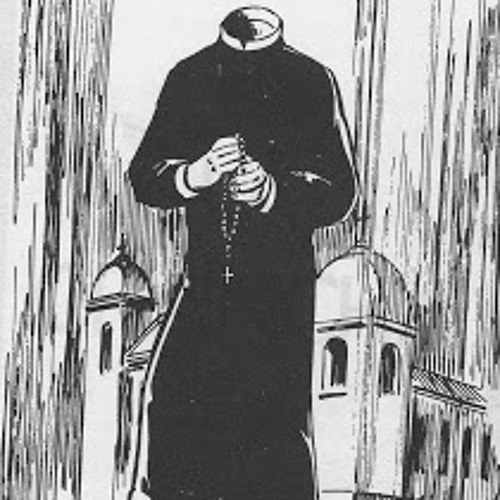
Objective: Learn new words from the text by matching them with their meanings.
Instructions: Match each word to its correct meaning by drawing a line or selecting the correct option.
- Legend
- Priest
- Gravedigger
- Coffin
- Devil
- Headless
- A story passed down through generations.
- A religious leader in a church.
- A person who digs graves for burials.
- A box used to bury a dead body.
- An evil spirit or figure often linked to hell.
- Without a head.
Objective: Understand key points of the text.
Instructions: Read the questions below and choose the correct answer.
- What did the priest do after his masses?
- Who attended the priest’s funeral?
- What was unusual about the priest’s body?
- What do people believe happened to the priest’s head?
Objective: Complete the following sentences based on the legend.
Play MinigameSe cuenta la leyenda que hace muchísimos años (de hecho, más de un siglo) había un sacerdote al que le gustaba salir con varias mujeres después de concluir sus misas.
Obviamente este tipo de conducta era rechazada por los moradores de Cuenca, pero lamentablemente nadie podía hacer nada para evitarlo, ya que el cura era amigo de las autoridades eclesiásticas que en algún momento pudieron removerlo.
El sacerdote siguió saliendo con varias muchachas solteras, hasta el día de su muerte. Se dice que a su funeral no acudió nadie, salvo el sepulturero.
Cuando el enterrador comenzaba a echar la tierra sobre el ataúd, la tapa de éste se abrió, permitiéndole ver que aquel cuerpo no tenía cabeza.
El hombre terminó de hacer su trabajo y luego se dirigió a una cantina en la que les relató a los asistentes lo sucedido. De inmediato hubo quienes afirmaron:
“De seguro fue el demonio el que se llevó su cabeza al infierno.”
Desde ese momento, el cuerpo del cura vaga por las noches con la esperanza de recuperar su cabeza.
The Black Horse of the Devil
In a small Salvadoran village, nights were known for their quiet, interrupted only by crickets and the wind. However, the elders warned of a danger that lurked for late-night wanderers: the Black Horse.
This horse, they said, was enormous, with eyes glowing like burning embers and a chilling neigh that froze the blood. It appeared on the darkest nights, chasing those who had done wrong or dared to walk alone on deserted paths past midnight.
One night, a man named Jacinto, known in the village for being quarrelsome and abusive, decided to head home after a night of drinking and gambling. Ignoring the warnings, he took a lonely forest trail. Suddenly, he heard a loud neigh that shook the ground beneath his feet. He turned, and there it was: the Black Horse, its mane flowing in the wind like flames.
Jacinto tried to run, but the horse caught up to him in the blink of an eye. They say the beast dragged him to the Lempa River, where he vanished without a trace. Jacinto was never seen again, but from that night on, whenever someone heard the Black Horse's neigh, they knew it was a warning to change their ways.
The village learned to respect the night, remembering that not everything lurking in the darkness is human, and that the Black Horse still roams, seeking souls worthy of its punishment.
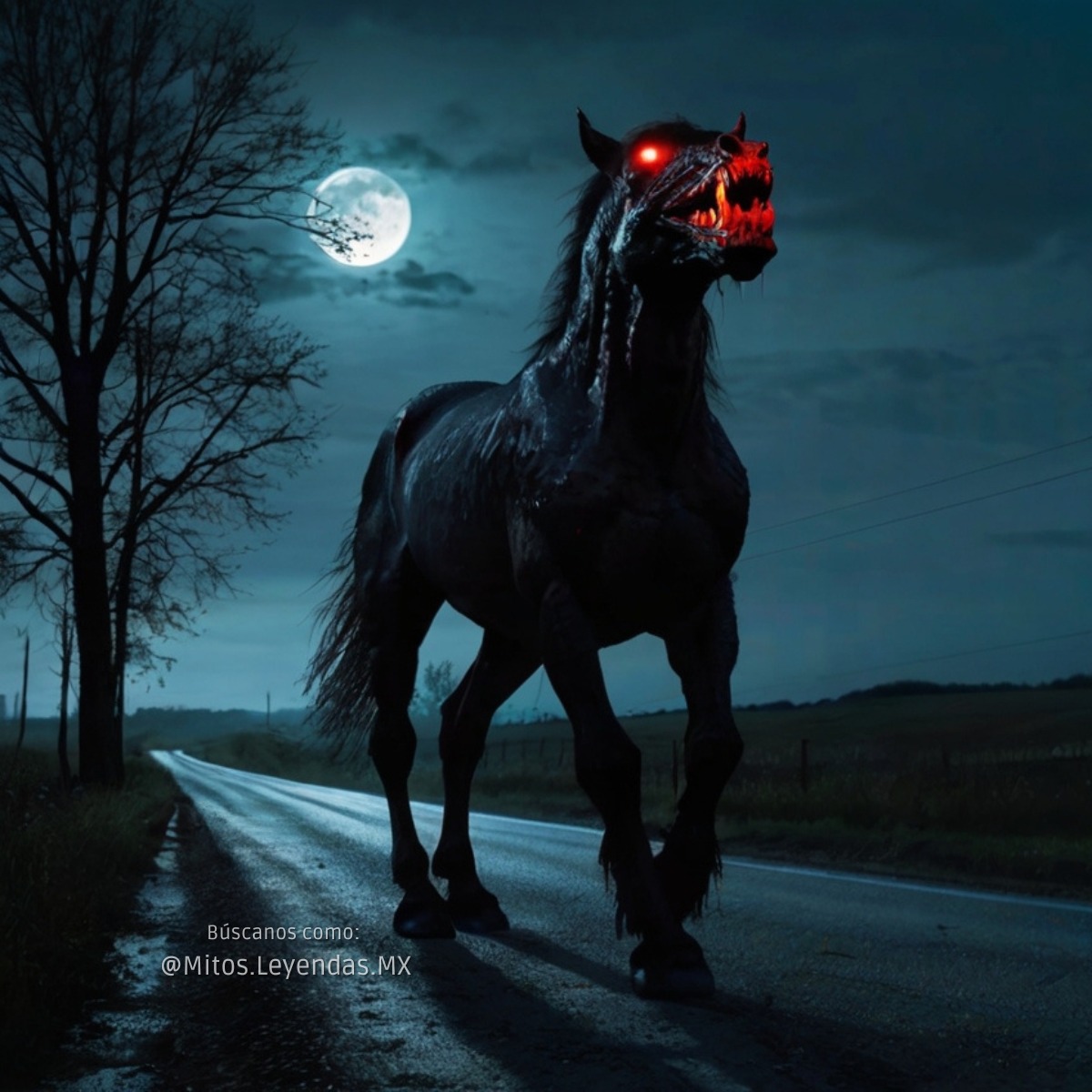
Objective: Match new vocabulary with simple definitions to expand word knowledge.
Instructions: Draw a line from each word in Column A to its correct definition in Column B.
- Neigh
- Village
- Elders
- Trail
- Lurk
- Punishment
Instructions: Choose True or False for the following statements.
- The Black Horse appeared only during the day.
- Jacinto was known for being kind and helpful in the village.
- The Black Horse had glowing red eyes.
- Jacinto vanished near the Lempa River.
- The villagers learned to respect the night after Jacinto disappeared.
Objective: Create an engaging game to reinforce vocabulary and story details.
Play MinigameEn un pequeño pueblo de El Salvador, las noches eran conocidas por su calma interrumpida solo por los grillos y el viento. Sin embargo, los ancianos advertían sobre un peligro que rondaba a los trasnochadores: el Caballo Negro.
Se decía que este caballo era enorme, con ojos rojos como brasas ardientes, y un relincho que helaba la sangre. Aparecía siempre en las noches más oscuras, persiguiendo a aquellos que habían cometido malas acciones o que osaban andar por caminos solitarios después de la medianoche.
Una noche, un hombre llamado Jacinto, conocido en el pueblo por ser pendenciero y abusivo, decidió volver a casa tras una noche de apuestas y alcohol. Ignorando las advertencias, tomó un sendero solitario por el bosque. De repente, escuchó un fuerte relincho que hizo temblar el suelo bajo sus pies. Giró la cabeza y allí estaba: el Caballo Negro, con su melena flotando al viento como si fuera fuego.
Jacinto intentó correr, pero el caballo lo alcanzó en un abrir y cerrar de ojos. Se dice que el animal lo arrastró hasta el río Lempa y lo hizo desaparecer. Nadie volvió a ver a Jacinto, pero desde entonces, cada vez que alguien escuchaba el relincho del Caballo Negro, sabía que era una advertencia para cambiar su camino.
El pueblo aprendió a respetar las noches, recordando que no todo lo que acecha en la oscuridad es humano, y que el Caballo Negro sigue vigilando, buscando almas que merezcan su castigo.
The Goblin
The Goblin is a spirit in love, always seeking out young and beautiful women, whom he won't leave alone until they do something unpleasant to him, like not bathing or engaging in unhygienic habits.
He won’t let the chosen pretty girl rest, tormenting her with noises at night, breezes, and scents, until he causes her to remain a spinster.
The most effective way to get rid of the goblin is to eat in the bathroom, as dirty young women disgust him, and that’s why he leaves. However, there’s something even worse: when the goblin never leaves, no matter how hard you try all the tricks the stories suggest.
There’s a tale of a very beautiful young woman who believed a goblin was in love with her and wouldn’t leave her alone. They say that one night, the girl was not in her bed and was found in the sewing room of the school she attended. She had over 50 pins stuck all over her body and could only cry. People told her, "Tell him to leave," and sprinkled holy water on her, but the goblin never left. One day, the young woman disappeared.
Other stories describe these strange beings as tiny men with pointed ears, fond of wearing luxurious, brightly colored clothing. They guard enormous pots filled with gold coins and speak a language only they understand.
In our culture, it is believed they are wandering spirits who visit homes where children behave badly, intending to take them away. That’s why our grandparents used to sing to us at bedtime, “If you don’t sleep, the goblin will come and take you away.”
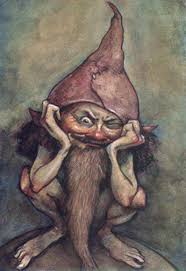
Objective: Learn and identify key words from the story.
Instructions: Match each word to its correct picture. Drag and drop the words to the image it describes.
- Goblin
- Pins
- Sewing Room
- Holy Water
- Gold Coins
Objective: Check understanding of the story.
Instructions: Select the correct answer for each question.
- What scares the goblin away?
- Why did the grandparents sing to the children?
- What did the goblin do to the young woman?
Objective: Create an engaging game to reinforce vocabulary and story details.
Play MinigameEl Duende es un espíritu enamorado que siempre busca a las mujeres jóvenes y bonitas, a las cuales no deja en paz hasta que hacen algo desagradable para él, como no bañarse o hacer cosas antihigiénicas.
No deja tranquila a la muchacha bonita que escoge, por medio de ruidos por las noches, brisas y aromas, hasta causar que se quede solterona.
La forma más efectiva de librarse del duende es comer en el baño, pues las jóvenes sucias le desagradan y por eso se va. Pero, hay algo aún más terrible: que el duende nunca se vaya por más que trates de hacer todo lo que dicen las historias, pues existe un relato de una joven muy hermosa que creía tener a un duende enamorado de ella y que no la dejaba en paz. Dicen que una noche la joven no estaba en su cama y fue encontrada en la costuraría del colegio donde estudiaba. Ella tenía incrustados más de 50 alfileres en todo su cuerpo, y la joven solo lloraba. Le decían, “Dile que se vaya”, le echaban agua bendita, pero el duende nunca se fue, y un día la muchacha desapareció.
También cuentan otras historias que estos extraños seres son hombrecitos muy pequeños y de orejas puntiagudas, les gusta vestir ropas muy lujosas y de colores brillantes; y son guardianes de enormes ollas llenas de monedas de oro, y hablan un idioma que solo ellos entienden.
En nuestro medio se cree que son espíritus en pena y llegan a la casa donde los niños tienen un comportamiento incorregible, para llevárselos; es por eso que nuestros abuelos nos cantaban a la hora de dormir: “Si no te duermes, va a venir el duende y te va a llevar.”
The Legend of the Chupacabra
In the fields, so dark and deep,
A creature prowls while the world sleeps.
Its eyes are red, and its body thin,
It comes for blood, to feast and win.
The Chupacabra, silent and fast,
Leaves behind a mystery that will last.
In the night, it moves with grace,
No trace left behind, no sign, no face.
You, the farmer with heart full of fear,
Search for answers but find none near.
And I, the voice that whispers true,
Tell you of the creature that haunts you too.
It strikes at midnight, with hunger strong,
Leaving behind a dreadful song.
But the wind knows, a chilling guide,
That some creatures in darkness hide.
Though the moon rises, and dawn breaks free,
The Chupacabra still roams, unseen by thee.
Its legend stays, a tale untold,
Of the creature that feeds, so silent, so bold.
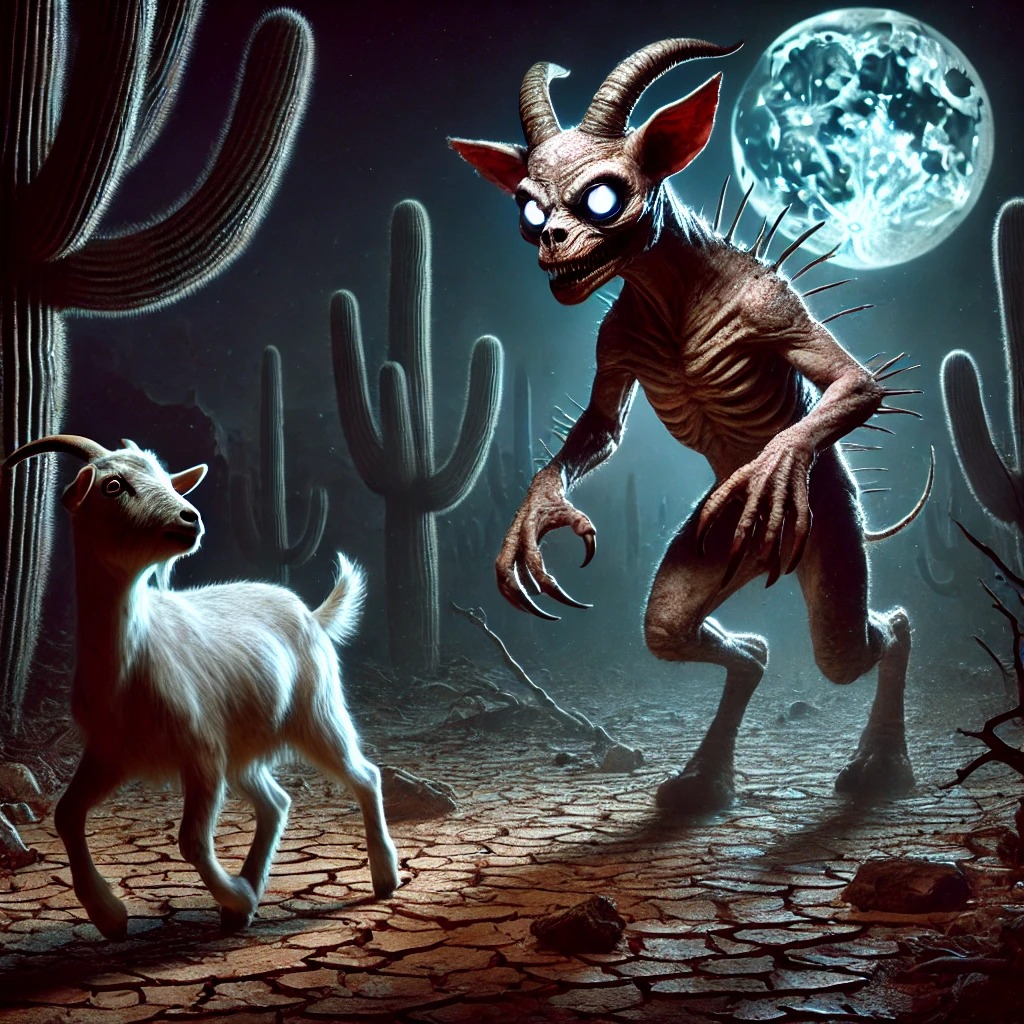
Objective: Learn and practice basic vocabulary related to the story.
Instructions: Read the following words from the story and look up their meaning in Spanish. Then, complete the sentences with the correct word.
- Creature
- Eyes
- Blood
- Silence
- Fear
- Midnight
- Wind
- Bold
Complete the sentences with the words above:
Objective: To make sure that the students understood the story.
Instructions: Read the story again and answer the following questions.
- What does the Chupacabra do in the fields?
- What is the Chupacabra’s appearance described as?
- What does the wind symbolize in the story?
- What time does the Chupacabra strike?
Objective: Improve identification and understanding of key words in the story.
Instructions: In the word search mini-game, you must find the words from the story in the word search puzzle. Each word you find is related to the story. Words can go in any direction: horizontally, vertically, diagonally.
Play MinigameEn los campos, tan oscuros y profundos,
Una criatura acecha mientras el mundo duerme.
Sus ojos son rojos, su cuerpo delgado,
Viene por sangre, para devorar y ganar.
El Chupacabra, silencioso y veloz,
Deja atrás un misterio que durará.
En la noche, se mueve con gracia,
Sin dejar rastro, sin señal, ni cara.
Tú, el granjero con el corazón lleno de miedo,
Buscas respuestas, pero no encuentras cerca ninguna.
Y yo, la voz que susurra la verdad,
Te cuento sobre la criatura que te acecha también.
Ataca a la medianoche, con hambre fuerte,
Dejando atrás una canción espantosa.
Pero el viento sabe, un guía escalofriante,
Que algunas criaturas se esconden en la oscuridad.
Aunque la luna suba, y amanezca el día,
El Chupacabra sigue rondando, invisible para ti.
Su leyenda permanece, una historia no contada,
De la criatura que se alimenta, tan silenciosa, tan audaz.
The Legend of La Llorona
In the night, so dark and cold,
A woman weeps, her story untold.
She walks along the river wide,
With tears that fall, no place to hide.
La Llorona, heartbroken and lost,
Roams the waters at a heavy cost.
Her children gone, her soul in pain,
She calls their names, but none remain.
You, the child who hears her cry,
Wonder if she’s just a whisper, or a lie.
And I, the wind that softly blows,
Tell you the truth that nobody knows.
In the darkness, she cries for her kids,
Her voice echoes in the night, as it bids,
For the souls of those who wander too near,
To the waters where La Llorona appears.
But the wind knows, a chilling sound,
That La Llorona’s sorrow knows no bounds.
Even when the moon hides its face,
Her cry will echo in time and space.

Objective: Learn and practice basic vocabulary related to the story.
Instructions: Read the following words from the story and look up their meaning in Spanish. Then, complete the sentences with the correct word.
- Woman
- Weeps
- River
- Children
- Lost
- Wind
- Cry
- Echoes
Complete the sentences with the words above:
Objective: To make sure that the students understood the story.
Instructions: Read the story again and answer the following questions.
Objective: Improve identification and understanding of key words in the story.
Instructions: In the word search mini-game, you must find the words from the story in the word search puzzle. Each word you find is related to the story. Words can go in any direction: horizontally, vertically, diagonally.
Play MinigameEn la noche, tan oscura y fría,
Una mujer llora, su historia perdida.
Camina por el río, tan ancho y profundo,
Con lágrimas que caen, sin lugar en el mundo.
La Llorona, con el corazón roto y perdido,
Ronda las aguas a un alto precio, confundido.
Sus hijos se fueron, su alma en dolor,
Grita sus nombres, pero ya no hay ningún amor.
Tú, el niño que escucha su lamento,
Te preguntas si es un susurro o un tormento.
Y yo, el viento que suavemente sopla,
Te cuento la verdad que nadie otra vez sabe.
En la oscuridad, llora por sus hijos,
Su voz resuena en la noche, pidiendo abrigo,
Por las almas de aquellos que se acercan demasiado,
A las aguas donde La Llorona ha quedado.
Pero el viento sabe, un sonido escalofriante,
Que el dolor de La Llorona no tiene fin, constante.
Aunque la luna esconda su cara,
Su llanto resonará en el tiempo y el espacio, con esperanza.
The Legend of Cuyancúa
In the mountains, so high and grand,
A village stood on sacred land.
The people lived in peace and grace,
Until the night that changed their place.
Cuyancúa, the moonlit child,
With eyes so bright, and spirit wild.
She danced beneath the silver glow,
Her beauty like the stars below.
But one dark night, the earth did shake,
And from the depths, the spirits wake.
Cuyancúa’s heart, so pure and true,
Could not escape what fate would do.
The villagers watched, filled with dread,
As spirits rose from the land of the dead.
They called her name with sorrowed cries,
But Cuyancúa, lost, did rise.
With voice so sweet, and tears like rain,
She whispered softly of her pain.
For she had fallen to the dark,
Her soul forever lost in the spark.
But the wind knows, through time and space,
Cuyancúa’s spirit, still holds a place.
And when the moon is high and bright,
Her dance is seen in the silent night.

Objective: Learn and practice basic vocabulary related to the story.
Instructions: Read the following words from the story and look up their meaning in Spanish. Then, complete the sentences with the correct word.
- Moonlit
- Dread
- True
- Spirit
- Escape
- Whispered
- Tears
- Dance
Complete the sentences with the words above:
Objective: To make sure that the students understood the story.
Instructions: Read the story again and answer the following questions.
Objective: Improve identification and understanding of key words in the story.
Instructions: In the word search mini-game, you must find the words from the story in the word search puzzle. Each word you find is related to the story. Words can go in any direction: horizontally, vertically, diagonally.
Play MinigameEn las montañas, tan altas y grandes,
Un pueblo estaba sobre tierras sagradas.
La gente vivía en paz y armonía,
Hasta la noche que cambió su melodía.
Cuyancúa, la niña de luz de luna,
Con ojos brillantes y alma en fortuna.
Bailaba bajo el resplandor plateado,
Su belleza, como las estrellas, aclamado.
Pero una noche oscura, la tierra tembló,
Y desde lo profundo, los espíritus despertó.
El corazón de Cuyancúa, tan puro y fiel,
No pudo escapar de su destino cruel.
Los aldeanos miraban, llenos de temor,
Mientras los espíritus surgían con su clamor.
Llamaban su nombre, con llanto y dolor,
Pero Cuyancúa, perdida, se elevó al ardor.
Con voz suave, y lágrimas como lluvia,
Susurraba su pena al viento, en su penuria.
Porque ella cayó en la oscuridad sin fin,
Su alma perdida en el fulgor sin fin.
Pero el viento sabe, a través del tiempo y el espacio,
El espíritu de Cuyancúa, aún tiene su abrazo.
Y cuando la luna brilla con su luz tan clara,
Su danza se ve en la noche, en el aire que no se para.
The Legend of La Siguanaba
Long ago, in the mountains of El Salvador, there was a beautiful woman named La Siguanaba. She lived alone in the forest and often walked by the river. Her beauty was so great that many men wanted to marry her. She wore a long white dress and had long, dark hair that shone like the night sky. However, La Siguanaba was not like other women.
One night, a young man named Tomas was walking home from the village. He had heard stories about the beautiful woman in the forest, but he didn’t believe them. Tomas was brave, and he thought the stories were just tales to scare children.
As he walked deeper into the forest, he saw a woman in the distance. She was standing near the river, looking at her reflection in the water. Her long white dress glowed in the moonlight. Tomas was amazed. He thought he had found the woman of his dreams.
He approached her and said, “Hello, beautiful lady. What is your name?”
The woman turned around slowly. Her face was hidden by her hair, but Tomas could see her glowing eyes. “I am La Siguanaba,” she said softly.
Tomas was enchanted. He asked her to marry him, and La Siguanaba agreed. But before he could come closer, she gave him a strange warning.
“You must never look at my face,” she said. “If you do, you will see a terrible secret.”
Tomas was curious, but he promised not to look at her face. However, as they began to walk together, Tomas felt more and more excited. He could not wait to see what La Siguanaba looked like up close.
Finally, his curiosity took over. He gently moved her hair aside to look at her face. What he saw made him scream in fear. Instead of a beautiful woman, he saw a hideous face with glowing eyes, a mouth full of sharp teeth, and a skull for a face. La Siguanaba was a spirit, a creature of the night.
Before Tomas could run away, La Siguanaba turned into a terrible monster and chased him. He ran as fast as he could, but the spirit was faster. Tomas could hear her laughing, and the sound echoed through the trees. He never returned to the village.
To this day, people say that La Siguanaba still walks the forests of El Salvador. She waits for those who do not listen to the warnings, and she teaches them to never be curious about things they should not see.
If you ever walk in the forest at night, remember the story of La Siguanaba. Keep your eyes forward and never look behind you.
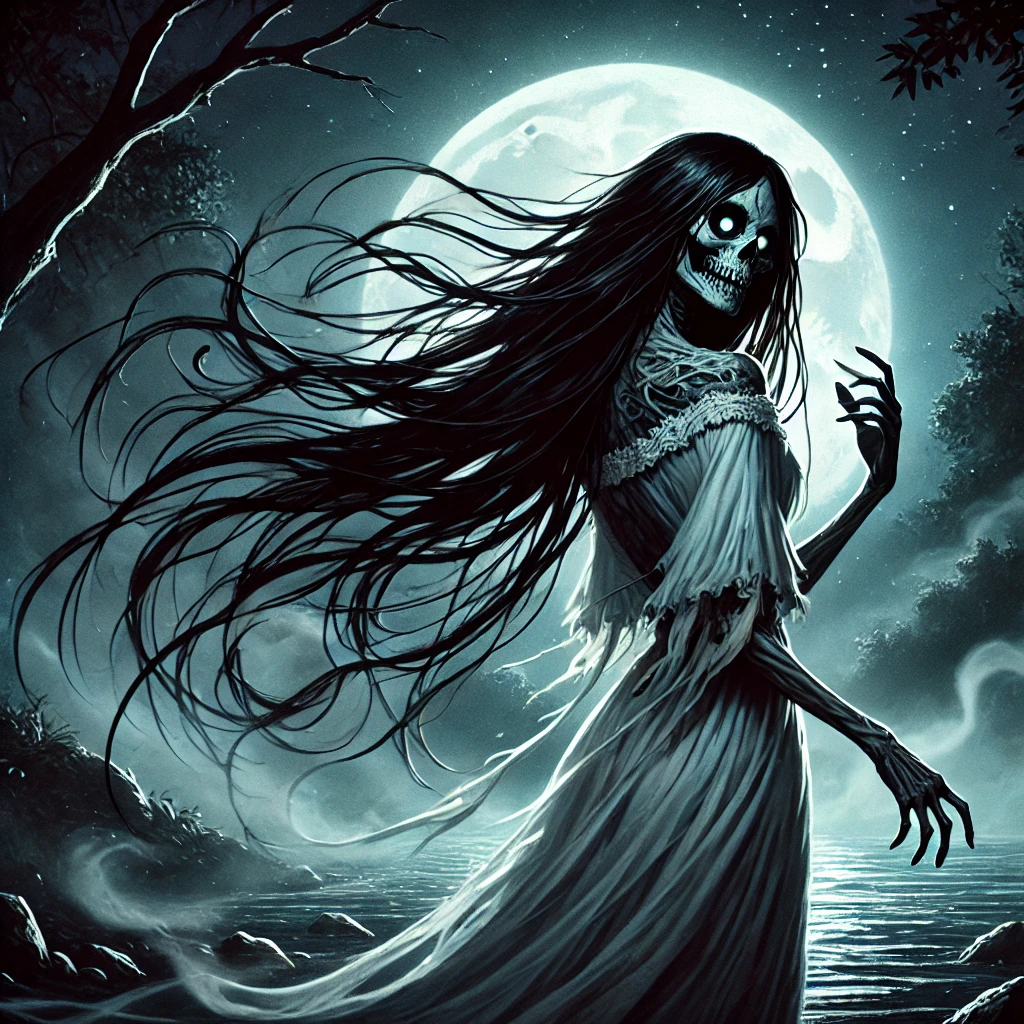
Objective: Learn and practice basic vocabulary related to the story.
Instructions: Read the following words from the story and look up their meaning in Spanish. Then, complete the sentences with the correct word.
- Strange
- Beauty
- Fear
- Gently
- Village
Complete the sentences with the words above:
Objective: To make sure that the students understood the story.
Instructions: Read the story again and answer the following questions.
Objective: Improve identification and understanding of key words in the story.
Instructions: In the word search mini-game, you must find the words from the story in the word search puzzle. Each word you find is related to the story. Words can go in any direction: horizontally, vertically, diagonally.
Play MinigameHace mucho tiempo, en las montañas de El Salvador, había una hermosa mujer llamada La Siguanaba. Vivía sola en el bosque y a menudo caminaba por el río. Su belleza era tan grande que muchos hombres querían casarse con ella. Llevaba un vestido largo blanco y tenía el pelo largo y oscuro que brillaba como el cielo nocturno. Sin embargo, La Siguanaba no era como las demás mujeres.
Una noche, un joven llamado Tomás regresaba caminando a casa desde el pueblo. Había oído historias sobre la hermosa mujer del bosque, pero no las creía. Tomás era valiente y pensaba que las historias eran solo cuentos para asustar a los niños.
Al adentrarse más en el bosque, vio a una mujer a lo lejos. Estaba de pie cerca del río, mirando su reflejo en el agua. Su largo vestido blanco brillaba a la luz de la luna. Tomás estaba asombrado. Pensó que había encontrado a la mujer de sus sueños.
Se acercó a ella y le dijo: “Hola, hermosa dama. ¿Cómo te llamas?”
La mujer se dio la vuelta lentamente. Su rostro estaba oculto por su cabello, pero Tomás podía ver sus ojos brillantes. “Soy La Siguanaba”, dijo suavemente.
Tomás estaba encantado. Le pidió que se casara con él, y La Siguanaba aceptó. Pero antes de que pudiera acercarse, ella le dio una extraña advertencia.
“Nunca debes mirarme a la cara”, dijo. “Si lo haces, verás un terrible secreto”.
Tomás tenía curiosidad, pero prometió no mirarla a la cara. Sin embargo, cuando comenzaron a caminar juntos, Tomás se sintió cada vez más emocionado. No podía esperar a ver cómo se veía La Siguanaba de cerca.
Finalmente, su curiosidad se apoderó de él. Le apartó suavemente el cabello para mirarla a la cara. Lo que vio lo hizo gritar de miedo. En lugar de una mujer hermosa, vio un rostro horrible con ojos brillantes, una boca llena de dientes afilados y una calavera por rostro. La Siguanaba era un espíritu, una criatura de la noche.
Antes de que Tomás pudiera escapar, La Siguanaba se convirtió en un terrible monstruo y lo persiguió. Corrió tan rápido como pudo, pero el espíritu era más rápido. Tomás podía oírla reír, y el sonido resonó entre los árboles. Nunca regresó al pueblo.
Hasta el día de hoy, la gente dice que La Siguanaba todavía camina por los bosques de El Salvador. Ella espera a quienes no escuchan las advertencias y les enseña a nunca sentir curiosidad por cosas que no deben ver.
Si alguna vez caminas por el bosque de noche, recuerda la historia de La Siguanaba. Mantén la vista hacia adelante y nunca mires hacia atrás.
The Legend of Cipitío
Once upon a time, in a small village in El Salvador, there was a mischievous little boy named Cipitío. He was no ordinary boy—he had a magical power that allowed him to play tricks on anyone who crossed his path. With his small size, he looked like a child, but his eyes were full of mischief, and his laugh was loud and wild.
Cipitío was always causing trouble. He would hide in the trees and scare the villagers by making strange noises. He loved to steal hats from men and run off, laughing as they chased him. He also liked to play tricks on the women, making them think they had lost their food or their belongings. Every time someone tried to catch him, he would vanish into thin air, leaving only his laughter behind.
But Cipitío was not just a troublemaker. He had a sad story. A long time ago, he was a normal boy who lived with his mother. One day, his mother told him not to go into the forest, but Cipitío didn’t listen. He went anyway, and while there, he met a powerful witch. The witch turned him into a little boy forever, and she gave him the power to trick others. From that day on, Cipitío was cursed to wander the earth, playing tricks on everyone he met.
Although many people tried to stop him, no one could. The villagers learned to live with Cipitío's tricks, and whenever they heard his laugh echoing through the trees, they knew he was near. Some even said that if you left him a small gift or food, he might leave you alone for a while. But others warned that if you were too mean to him, Cipitío would make your life difficult with his endless tricks.
To this day, people in El Salvador tell stories about Cipitío. They say that he still lives in the hills, watching from the shadows, waiting for someone to fall into his mischief. And if you listen closely on a quiet night, you might just hear his laugh echoing in the wind.
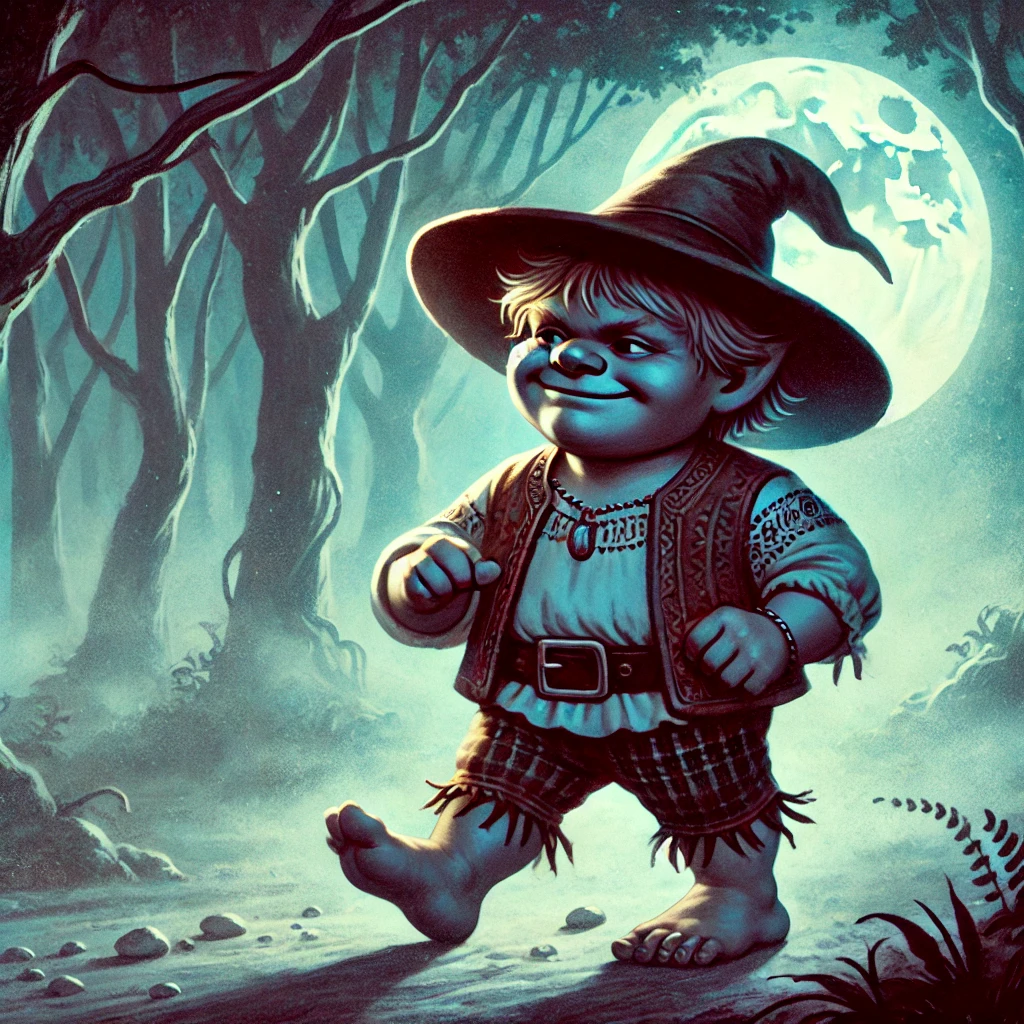
Objective: Learn and practice basic vocabulary related to the story.
Instructions: Read the following words from the story and look up their meaning in Spanish. Then, complete the sentences with the correct word.
- Witch
- Tricks
- Forest
- Hide
- Shadows
Complete the sentences with the words above:
Objective: To make sure that the students understood the story.
Instructions: Read the story again and answer the following questions.
Objective: Improve identification and understanding of key words in the story.
Instructions: In the word search mini-game, you must find the words from the story in the word search puzzle. Each word you find is related to the story. Words can go in any direction: horizontally, vertically, diagonally.
Play MinigameÉrase una vez, en un pequeño pueblo de El Salvador, un niño travieso llamado Cipitío. No era un niño común y corriente: tenía un poder mágico que le permitía hacerle bromas a cualquiera que se cruzara en su camino. Con su pequeño tamaño, parecía un niño, pero sus ojos estaban llenos de travesuras y su risa era fuerte y salvaje.
Cipitío siempre estaba causando problemas. Se escondía en los árboles y asustaba a los aldeanos haciendo ruidos extraños. Le encantaba robarles los sombreros a los hombres y salir corriendo, riéndose mientras lo perseguían. También le gustaba hacerles bromas a las mujeres, haciéndoles creer que habían perdido su comida o sus pertenencias. Cada vez que alguien intentaba atraparlo, se desvanecía en el aire, dejando solo su risa.
Pero Cipitío no era solo un alborotador. Tenía una historia triste. Hace mucho tiempo, era un niño normal que vivía con su madre. Un día, su madre le dijo que no fuera al bosque, pero Cipitío no le hizo caso. De todos modos, fue y, mientras estaba allí, conoció a una poderosa bruja. La bruja lo convirtió en un niño pequeño para siempre y le dio el poder de engañar a los demás. A partir de ese día, Cipitío fue maldecido para vagar por la tierra, gastando bromas a todo el que se cruzara en su camino.
Aunque muchas personas intentaron detenerlo, nadie pudo. Los aldeanos aprendieron a vivir con las bromas de Cipitío y, cada vez que escuchaban su risa resonando entre los árboles, sabían que estaba cerca. Algunos incluso decían que si le dejabas un pequeño regalo o comida, podría dejarte en paz por un tiempo. Pero otros advertían que si eras demasiado malo con él, Cipitío te haría la vida difícil con sus interminables trucos.
Hasta el día de hoy, la gente de El Salvador cuenta historias sobre Cipitío. Dicen que todavía vive en las colinas, observando desde las sombras, esperando que alguien caiga en sus travesuras. Y si escuchas con atención en una noche tranquila, es posible que escuches su risa resonando en el viento.
The Legend of La Carreta Chillona
In a small town in El Salvador, there was a legend about La Carreta Chillona (The Screeching Cart). People said it appeared late at night, carrying the souls of those who had done bad things.
The cart was old, made of wood, and had no oxen or horses pulling it. Instead, it moved on its own. Its wheels made a loud, chilling screeching sound that could wake up the entire town. When people heard it, they stayed inside their homes, locked their doors, and prayed.
One night, a man named Juan decided to find out if the legend was true. He was a brave but curious man. His friends warned him, but he didn’t listen. He waited by the road outside the town, where the cart was said to pass.
As midnight came, the wind grew cold, and the air felt heavy. Suddenly, Juan heard the sound—an eerie screeching noise that grew louder and louder. His heart raced, but he stayed still, determined to see it.
Out of the darkness, the cart appeared. It looked exactly as people described—old, broken, and moving without anything pulling it. Inside the cart, Juan saw glowing red lights that looked like eyes staring back at him.
Fear took over, and Juan tried to run, but his legs wouldn’t move. The cart stopped in front of him, and a cold voice whispered, “Why are you here?” Trembling, Juan couldn’t answer. The cart let out a loud screech, and then it disappeared into the night.
From that day on, Juan never spoke about what he saw. He stayed inside every night and warned others to respect the legend of La Carreta Chillona.
People in the town still hear the cart sometimes, reminding everyone that some things are better left unseen.
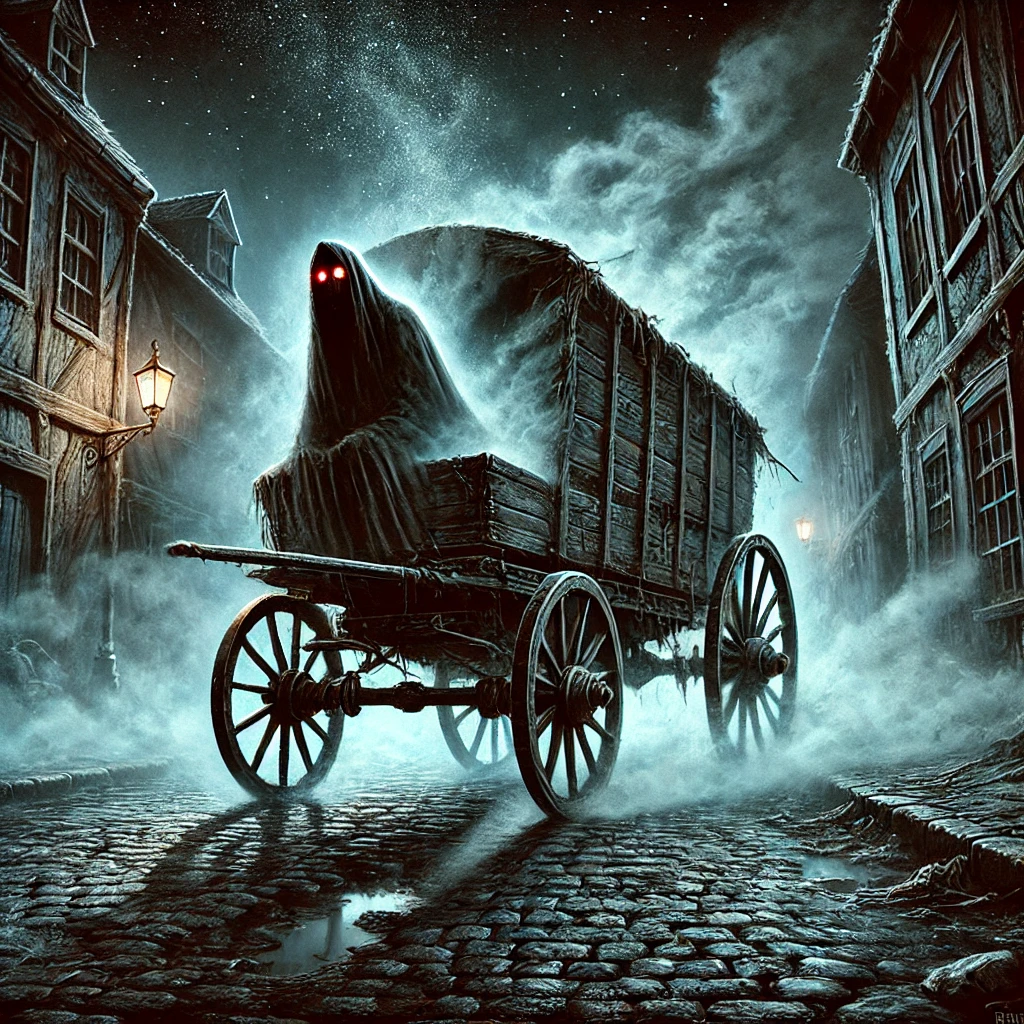
Objective: Learn and practice basic vocabulary related to the story.
Instructions: Read the following words from the story and look up their meaning in Spanish. Then, complete the sentences with the correct word.
- Souls
- Town
- Oxen
- Broken
- Voice
Complete the sentences with the words above:
Objective: To make sure that the students understood the story.
Instructions: Read the story again and answer the following questions.
Objective: Improve identification and understanding of key words in the story.
Instructions: In the word search mini-game, you must find the words from the story in the word search puzzle. Each word you find is related to the story. Words can go in any direction: horizontally, vertically, diagonally.
Play MinigameEn un pequeño pueblo de El Salvador, existía una leyenda sobre La Carreta Chillona. La gente decía que aparecía tarde en la noche, llevando las almas de aquellos que habían hecho cosas malas.
La carreta era vieja, estaba hecha de madera y no tenía bueyes ni caballos que la jalaran. En cambio, se movía por sí sola. Sus ruedas producían un sonido chirriante y escalofriante que podía despertar a todo el pueblo. Cuando la gente lo escuchaba, se quedaban dentro de sus casas, cerraban las puertas y rezaban.
Una noche, un hombre llamado Juan decidió averiguar si la leyenda era cierta. Era un hombre valiente pero curioso. Sus amigos le advirtieron, pero él no escuchó. Esperó junto al camino fuera del pueblo, por donde se decía que pasaba la carreta.
Cuando llegó la medianoche, el viento se volvió frío y el aire se sintió pesado. De repente, Juan escuchó el sonido: un chirrido espeluznante que se hacía cada vez más fuerte. Su corazón se aceleró, pero se quedó quieto, decidido a verlo. De la oscuridad surgió el carro. Era exactamente como lo habían descrito las personas: viejo, roto y se movía sin que nadie lo jalara. Dentro del carro, Juan vio luces rojas brillantes que parecían ojos que lo miraban fijamente.
El miedo se apoderó de él y Juan trató de correr, pero sus piernas no se movían. El carro se detuvo frente a él y una voz fría le susurró: “¿Por qué estás aquí?”. Juan temblaba y no pudo responder. El carro emitió un chirrido fuerte y luego desapareció en la noche.
Desde ese día, Juan nunca habló de lo que vio. Se quedaba adentro todas las noches y advertía a los demás que respetaran la leyenda de La Carreta Chillona.
La gente del pueblo todavía escucha el carro a veces, lo que les recuerda a todos que algunas cosas es mejor no verlas.
The Flower of Amate
The elders of the village say that under an old amate tree, a young girl with deep eyes cried for her lonely love.
She loved a brave young warrior, strong like the rising sun, but cruel destiny kept them apart forever.
One night, under the fading moon, he left for a distant war, and she stayed, waiting for him, beside the tree that heard her heart.
Day after day, she prayed to the amate, a silent witness to her pain, until her tears became quiet, and her soul joined her again.
They say that at the next sunrise, a flower bloomed on the amate tree, fragile, white, and soft, like a whisper full of love.
Since that day, in Salvadoran lands, the amate blooms with eternal love, a memory of the young girl and her pure, serene romance.
The flower, small and brief, is a symbol of love and devotion, and the amate, strong and wise, keeps their love like a song.
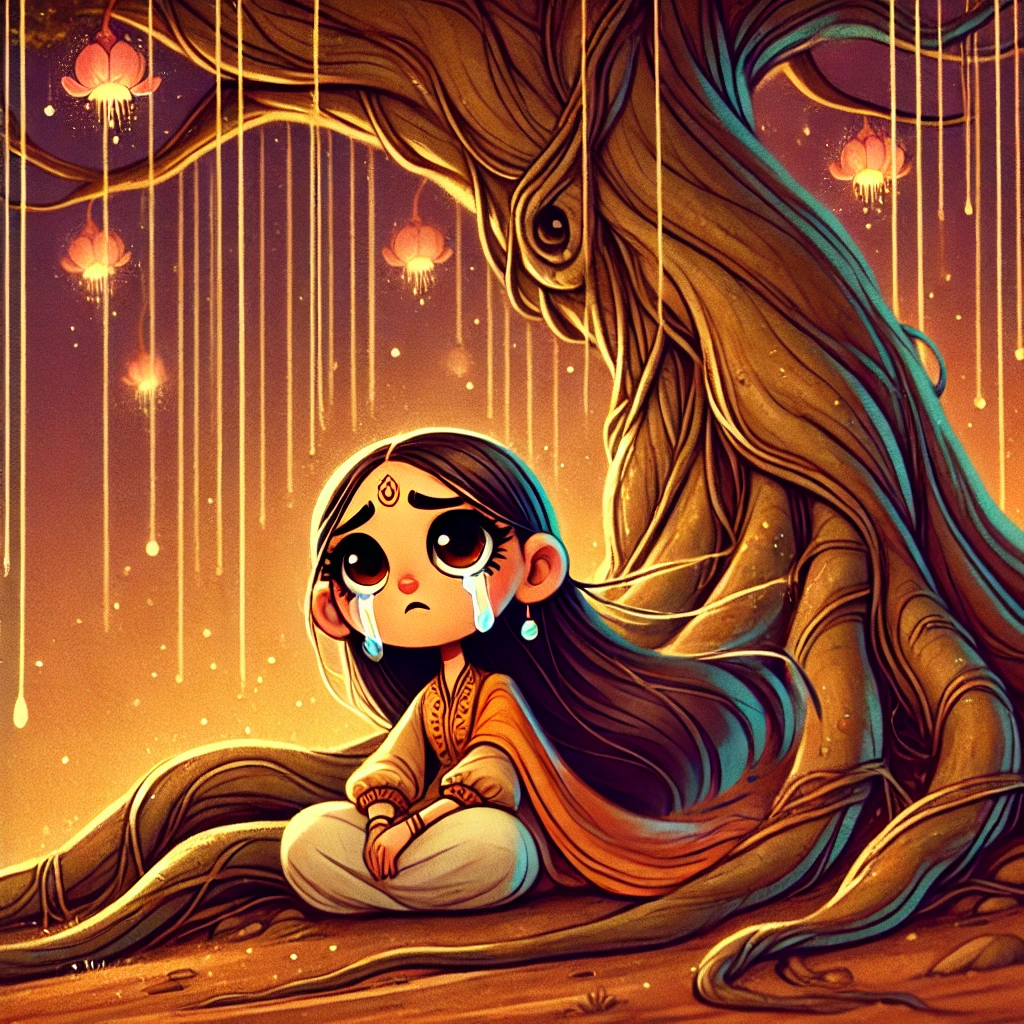
Objective: Learn and practice basic vocabulary related to the story.
Instructions: Read the following words from the story and their meanings in Spanish.
- Tree - Árbol
- Flower - Flor
- Love - Amor
- Warrior - Guerrero
- Moon - Luna
- Tears - Lágrimas
- Pain - Dolor
- Sunrise - Amanecer
Instructions: Complete the sentences with the correct word in English: Tree, Love, Flower, Moon, Tears, Sunrise.
Instructions: Read the story again and answer the following questions.
Objective: Match the words in English with their translations in Spanish.
Instructions: Play the matching game to practice vocabulary.
Play MinigameCuentan los ancianos del pueblo, que, bajo un amate milenario, una doncella de ojos profundos, lloró su amor solitario.
Ella amaba a un joven guerrero, valiente como el sol naciente, pero el destino cruel y severo los separó para siempre.
Una noche de luna menguante, él partió hacia una guerra lejana, y ella quedó esperando su vuelta, junto al árbol que ahora la llama.
Día tras día rezaba al amate, testigo eterno de su dolor, hasta que su llanto se hizo silencio y su alma se fundió en su amor.
Dicen que, al amanecer siguiente, brotó del amate una flor, fragante, delicada y blanca, como un suspiro lleno de ardor.
Desde entonces, en tierras salvadoreñas, el amate florece en amor eterno, como un recuerdo de aquella doncella, y su romance puro y sereno.
La flor, pequeña y efímera, es símbolo de entrega y pasión, y el amate, fuerte y sabio, guarda su amor como canción.
The Water Chasca
Long ago, in a small Salvadoran village, there was a beautiful girl named Chasca, who lived near a river full of crystal-clear water. She was known for her kindness and bright smile.
One day, a young man named Guillermo came to the village in search of work. He saw Chasca by the river and fell in love with her at first sight. He admired her beauty and grace.
Chasca also felt an instant connection with Guillermo, and they spent many days together, talking and laughing by the river, where the water seemed to dance with joy.
But soon, the river began to dry up, and the villagers became worried. They asked Chasca for help, for they believed she had a special bond with the water.
Chasca went to the river one evening, praying for the water to return, and as she spoke, the river suddenly started flowing again, bringing life to the village once more.
Grateful, the villagers celebrated, but Chasca disappeared, never to be seen again. They say that her spirit now lives in the river, and that every time the river flows, it is a reminder of her kindness and love for nature.
From that day on, the villagers call the river La Chasca del Agua (The Water Chasca), a symbol of life and harmony with nature.

Objective: Learn and practice basic vocabulary related to the story.
Instructions: Read the following words from the story and their meanings in Spanish.
- River - Río
- Water - Agua
- Girl - Chica
- Love - Amor
- Work - Trabajo
- Spirit - Espíritu
- Kindness - Bondad
- Flow - Fluir
Instructions: Complete the sentences with the correct word in English: River, Water, Girl, Love, Work, Spirit, Kindness, Flow.
Instructions: Read the story again and answer the following questions.
Objective: Match the words in English with their translations in Spanish.
Instructions: Play the matching game to practice vocabulary.
Play MinigameHace mucho tiempo, en un pequeño pueblo salvadoreño, vivía una hermosa joven llamada Chasca, que vivía cerca de un río de aguas cristalinas. Era conocida por su bondad y su brillante sonrisa.
Un día, un joven llamado Guillermo llegó al pueblo en busca de trabajo. Vio a Chasca cerca del río y se enamoró de ella a primera vista. Admiraba su belleza y gracia.
Chasca también sintió una conexión inmediata con Guillermo, y pasaron muchos días juntos, hablando y riendo junto al río, donde el agua parecía bailar de alegría.
Pero pronto, el río comenzó a secarse, y los habitantes del pueblo se preocuparon. Le pidieron ayuda a Chasca, porque creían que ella tenía un vínculo especial con el agua.
Chasca fue al río una tarde, rezando para que el agua regresara, y mientras hablaba, el río comenzó a fluir nuevamente, trayendo vida al pueblo una vez más.
Agradecidos, los habitantes celebraron, pero Chasca desapareció, nunca más se la vio. Dicen que su espíritu ahora vive en el río, y que cada vez que el río fluye, es un recordatorio de su bondad y amor por la naturaleza.
Desde ese día, los habitantes del pueblo llaman al río La Chasca del Agua, un símbolo de vida y armonía con la naturaleza.
The Legend of the Cadejo
A long time ago, in the forests of El Salvador, there was a strange creature known as the Cadejo. It was said to be a large, black dog with glowing red eyes, and it roamed the night, looking for travelers.
The Cadejo was feared by the people, for it was said that whoever met it would never return. Some said it was a guardian spirit, while others believed it was a demon sent to harm those who strayed too far.
One night, a young man named Ricardo was traveling through the forest alone. He had heard the stories of the Cadejo but did not believe them. As he walked through the dark woods, he suddenly heard the growl of the creature behind him.
Ricardo turned around and saw the large black dog with red eyes staring at him. He tried to run, but the Cadejo followed him, its growl growing louder with every step.
But just as the creature was about to catch him, Ricardo saw a second dog, white and glowing, appear beside him. The white Cadejo fought the dark one, and with a final growl, the dark Cadejo ran away, disappearing into the night.
From that day on, people said that the Cadejo had two forms: a black one, which was evil, and a white one, which protected those who were lost or in danger. The legend of the Cadejo still lives on, reminding people of the mysterious forces that roam the night.
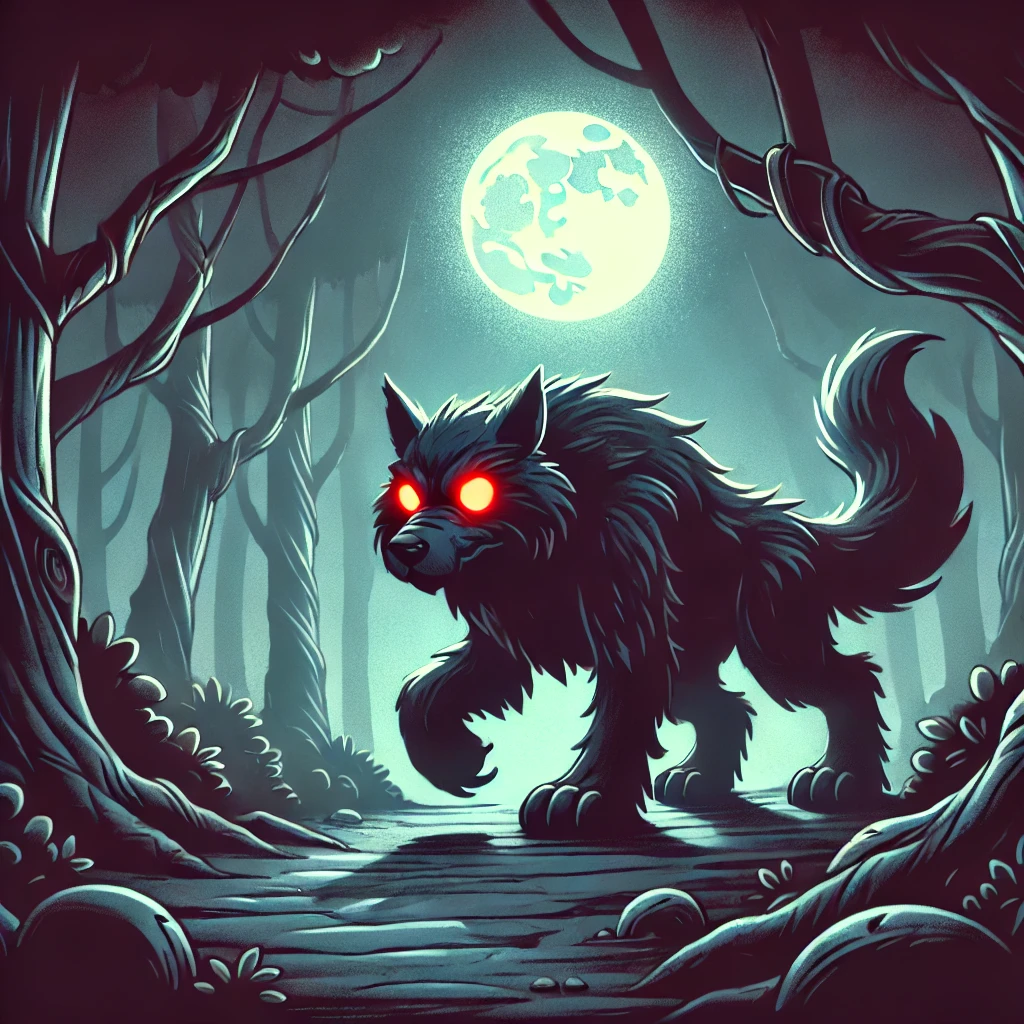
Objective: Learn and practice basic vocabulary related to the story.
Instructions: Read the following words from the story and their meanings in Spanish.
- Dog - Perro
- Night - Noche
- Travel - Viajar
- Creature - Criatura
- Guardian - Guardián
- Fear - Miedo
- Eyes - Ojos
- Fight - Pelear
Instructions: Complete the sentences with the correct word in English: Dog, Night, Travel, Creature, Guardian, Fear, Eyes, Fight.
Instructions: Read the story again and answer the following questions.
Objective: Match the words in English with their translations in Spanish.
Instructions: Play the matching game to practice vocabulary.
Play MinigameHace mucho tiempo, en los bosques de El Salvador, existía una extraña criatura conocida como el Cadejo. Se decía que era un gran perro negro con ojos rojos brillantes, y vagaba por la noche en busca de viajeros.
El Cadejo era temido por la gente, pues se decía que quien se encontraba con él nunca regresaba. Algunos decían que era un espíritu guardián, mientras que otros creían que era un demonio enviado para dañar a los que se adentraban demasiado en el bosque.
Una noche, un joven llamado Ricardo viajaba solo por el bosque. Había oído hablar del Cadejo, pero no creía en las historias. Mientras caminaba por el oscuro bosque, de repente escuchó el gruñido de la criatura detrás de él.
Ricardo se dio vuelta y vio al gran perro negro con los ojos rojos mirándolo fijamente. Trató de correr, pero el Cadejo lo siguió, y su gruñido crecía más fuerte con cada paso.
Pero justo cuando la criatura estaba a punto de alcanzarlo, Ricardo vio a otro perro, blanco y brillante, aparecer a su lado. El Cadejo blanco peleó contra el negro, y con un último gruñido, el Cadejo negro huyó, desapareciendo en la noche.
Desde ese día, la gente decía que el Cadejo tenía dos formas: una negra, que era maligna, y una blanca, que protegía a los perdidos o a aquellos en peligro. La leyenda del Cadejo sigue viva, recordando a las personas las fuerzas misteriosas que rondan la noche.




